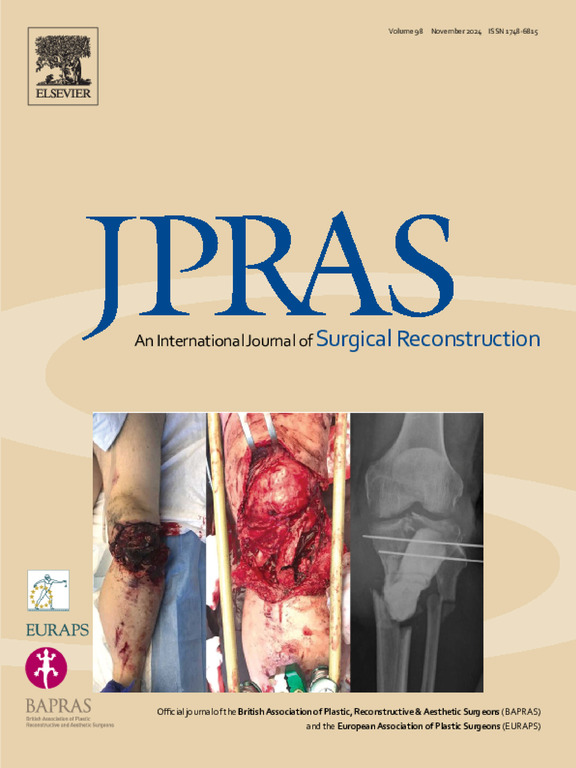突出或隐藏:通过形态计量分析确定亚洲人的理想颅耳角
IF 2
3区 医学
Q2 SURGERY
Journal of Plastic Reconstructive and Aesthetic Surgery
Pub Date : 2025-01-01
DOI:10.1016/j.bjps.2024.11.060
引用次数: 0
摘要
简介耳朵的正面外观通常在面部美学中被忽视,但在亚洲人中却越来越受到关注。然而,目前尚未就理想的颅耳角达成共识。本研究旨在通过问卷调查,了解亚洲人心目中的理想颅耳角:方法:通过人工发放问卷的方式,对不同背景的人群进行调查。要求参与者对一系列描绘典型亚洲人面部特征的图片进行评估,并对耳朵进行数字处理,以展示不同的颅耳角度。问卷还记录了参与者的人口统计学信息,包括年龄、性别、职业、脸型和耳型,以及是否曾为美观目的做过耳部整形手术:结果:共记录了 632 个回答。无论性别和脸型如何,颅耳角为 30 度的受访者得分最高:这项研究深入揭示了基于性别和脸型的最佳颅耳角。颅耳角为 30 度的耳朵是调查参与者的首选。这些发现为耳部整形手术的手术规划和效果评估提供了宝贵的指导。本文章由计算机程序翻译,如有差异,请以英文原文为准。
Protruding or concealed: Defining ideal cranioauricular angle via a morphometric analysis in Asians
Introduction
The frontal appearance of ears, usually overlooked in facial aesthetics, has gained increasing attention among Asians. However, a consensus on the ideal cranioauricular angle is currently lacking. This study aims to investigate the ideal cranioauricular angle as perceived by the Asian population through a questionnaire-based survey.
Methods
A survey was conducted among a diverse population of varying backgrounds by distributing questionnaires manually. The participants were requested to evaluate a series of images depicting typical Asian facial features, with ears digitally manipulated to demonstrate distinct cranioauricular angles. Demographic information, including age, gender, occupation, their own face and ear type, and history or interest in otoplasty for aesthetic purposes, was recorded.
Results
A total of 632 responses were recorded. The cranioauricular angle of 30 degrees received the highest scores from respondents, regardless of gender and face shape (P<0.0001), which corresponded to an upper width facial ratio of 0.79–0.82 and a lower facial width ratio of 0.67–0.70. Subgroup analysis revealed ideal angle lies between 30 and 40 degrees, with slight differences when stratified by age, gender, or occupation. Auricles that are excessively protruded or concealed were not preferred. Among respondents with a slender face, 20.5% expressed interest in otoplasty, compared to 15.27% among those with a broader face.
Conclusion
This study provides an in-depth insight into the optimal cranioauricular angle based on gender and facial shape. The ear with a cranioauricular angle of 30 degrees is the preferred option among participants in the survey. These findings offer valuable guidance for surgical planning and outcome assessment in cosmetic otoplasty.
求助全文
通过发布文献求助,成功后即可免费获取论文全文。
去求助
来源期刊
CiteScore
3.10
自引率
11.10%
发文量
578
审稿时长
3.5 months
期刊介绍:
JPRAS An International Journal of Surgical Reconstruction is one of the world''s leading international journals, covering all the reconstructive and aesthetic aspects of plastic surgery.
The journal presents the latest surgical procedures with audit and outcome studies of new and established techniques in plastic surgery including: cleft lip and palate and other heads and neck surgery, hand surgery, lower limb trauma, burns, skin cancer, breast surgery and aesthetic surgery.

 求助内容:
求助内容: 应助结果提醒方式:
应助结果提醒方式:


